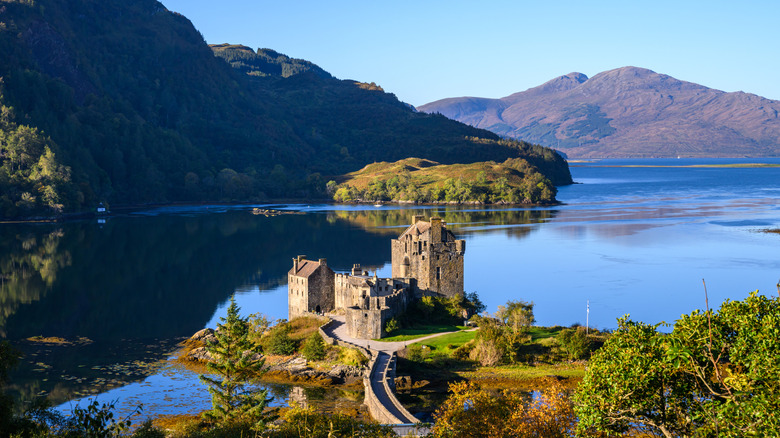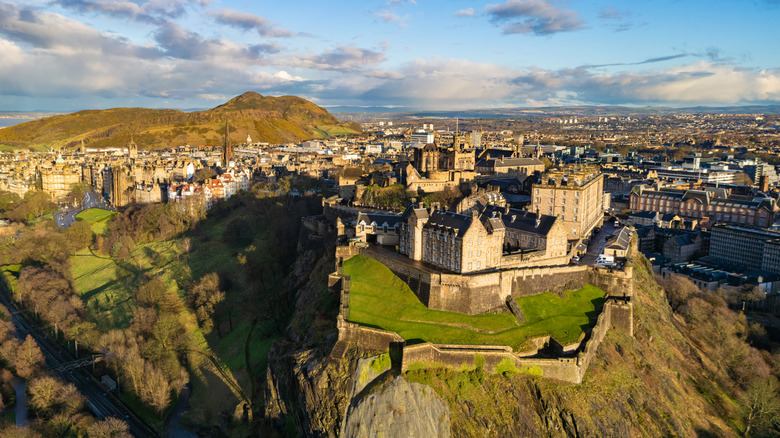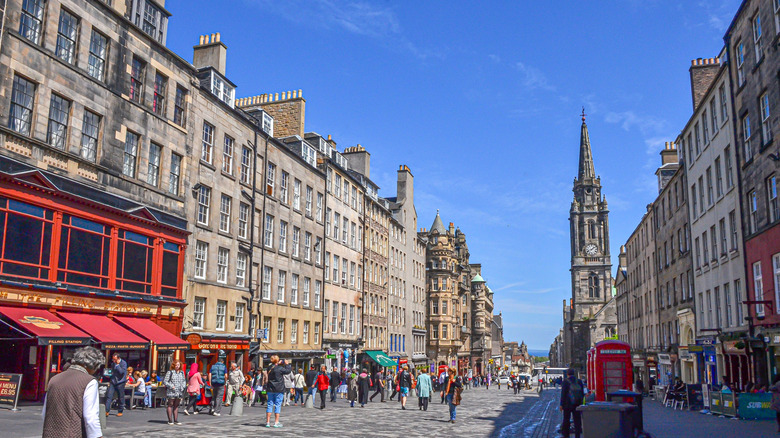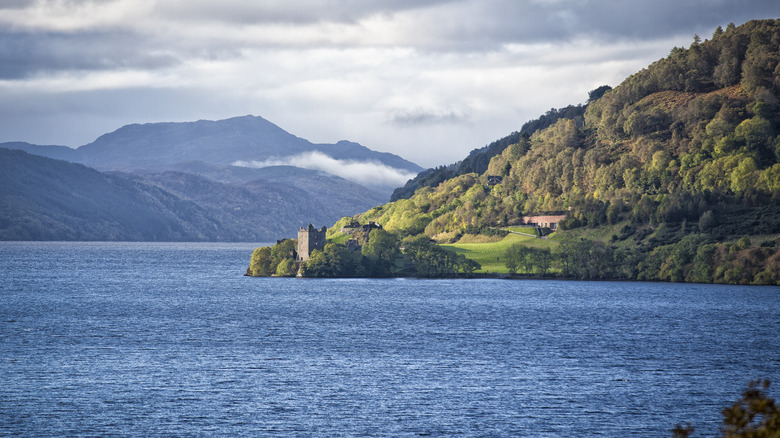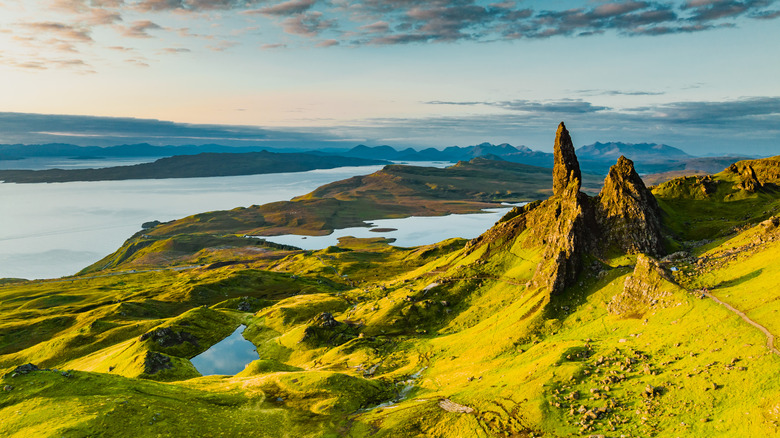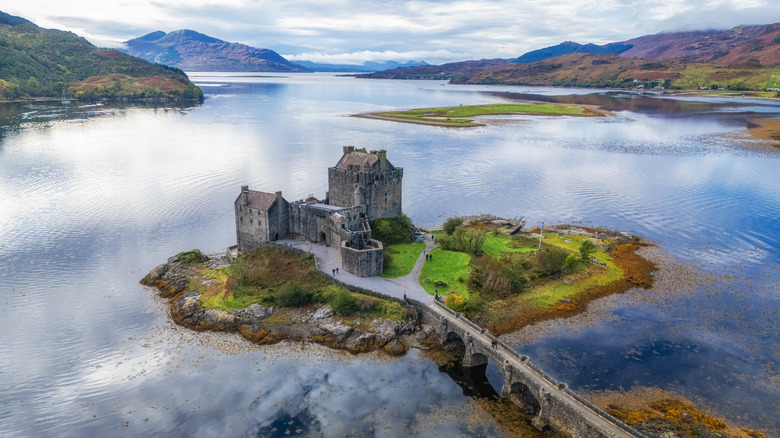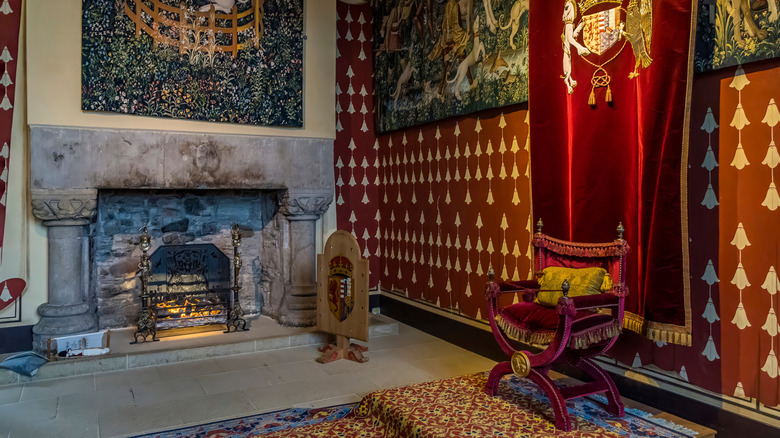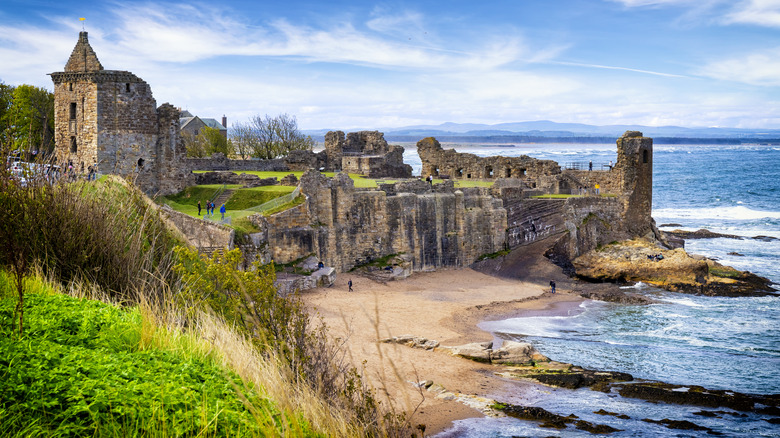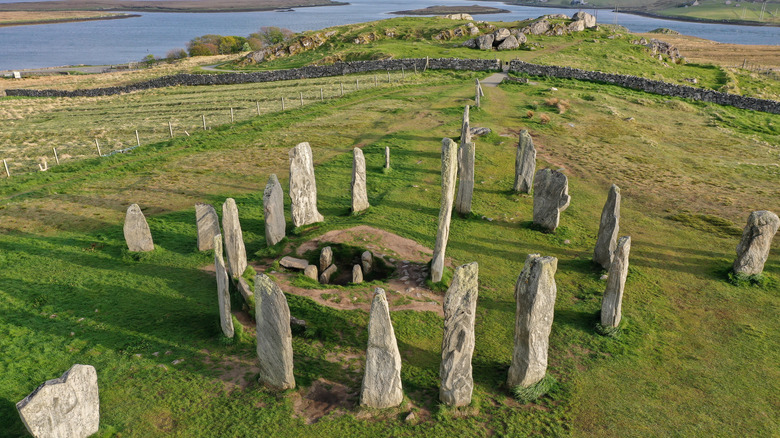Scotland's 14 Top-Tier Tourist Attractions For Your First Trip
Scotland packs an impressive range of experiences into a relatively small area, which makes it ideal for a first trip. Historic cities sit close to dramatic glens, island viewpoints, and coastal roads, while centuries of culture, architecture, and storytelling shape everyday life. This variety means visitors can easily move between urban highlights and wide-open landscapes without spending days on the road or in the air.
Together with the best activities that can't be missed on a trip to Scotland, these 14 attractions represent the stops every first-time visitor should seek out. All are straightforward to reach and contribute something distinct to an itinerary, whether through history, landscape, or cultural significance. As a whole, they work together to provide a broad look at Scotland — from castles and city landmarks to lochs, coastal viewpoints, and island settings. Ultimately, for travelers mapping out a first trip, they form a clear and well-rounded starting point for understanding what makes Scotland so special, and will undoubtedly inspire subsequent trips to this unique country.
Edinburgh Castle (Edinburgh)
Edinburgh Castle dominates the city skyline from its position atop Castle Rock, a volcanic outcrop that has served as a defensive stronghold for centuries. The approach gives a sense of its scale, with stone walls rising sharply above the historic and winding streets below. Inside, a series of courtyards and buildings reveal layers of Scottish history — from royal residences and medieval battlements to the Honours of Scotland, the oldest Crown Jewels in Britain. Views from the ramparts stretch across the Old Town's rooftops and out toward a peak known as Arthur's Seat, giving visitors a strong sense of the city's layout and surrounding landscape.
Despite its popularity, the site is well organized and easy to explore at your own pace. Clear pathways guide you past military museums, the Great Hall, and Mons Meg, a 15th-century siege cannon. The mix of open spaces and enclosed rooms offers a steady rhythm and variety as you move through the castle grounds. For many visitors, this is the first major landmark they visit in Scotland, and it definitely sets the tone: historic, visually striking, and firmly tied to the country's wider story.
The Royal Mile (Edinburgh)
One of the best sightseeing walks in Europe, The Royal Mile — running between Edinburgh Castle and the Palace of Holyroodhouse — forms the spine of the city's Old Town, offering a clear sense of how Edinburgh grew around its central ridge. Its cobbled streets, narrow closes, and tall tenements offer a straightforward introduction to the city's medieval character. Shops, cafés, small museums, and historic sites line the route, making it easy to explore in short sections or as a continuous walk.
Several landmarks also sit directly along the route — including St Giles' Cathedral, the Scottish Parliament building, and the Museum of Edinburgh — housed in buildings that reflect different periods of the city's development. Side alleys reveal quieter corners, some leading to viewpoints over the New Town or down toward the Grassmarket. Despite being one of Scotland's busiest tourist streets, the Royal Mile remains engaging for first-time visitors thanks to its mix of architecture, atmosphere, and walkability.
Loch Ness (Scottish Highlands)
Loch Ness is one of Scotland's most reknowned bodies of water, stretching for more than 20 miles through a deep, narrow valley carved by ice. Its dark, peat-stained surface gives it a distinctive appearance, and the surrounding hills rise steeply on both sides, creating a long corridor of scenery that feels both grand and contained. Villages and viewpoints dot the shores, with Drumnadrochit acting as a common base for visitors exploring the area. Urquhart Castle (pictured), perched on a promontory above the shore, offers one of the most striking vantage points: the ruins frame the water and give a sense of how long the loch has played a part in Highland history
Loch Ness is also firmly tied to one of Scotland's best-known legends. Stories of "Nessie," the mysterious Loch Ness Monster, have circulated for generations — adding a layer of curiosity that continues to draw visitors from around the world. In fact, you can even join a tour to explore the depths of this legendary body of water. Even without the folklore, though, the loch holds strong appeal thanks to its atmosphere and scale. However, if you prefer an even quieter spot, Scotland's first National Park is home to the country's biggest loch, which is less crowded than Loch Ness.
Glencoe (Scottish Highlands)
Glencoe is one of Scotland's most dramatic landscapes, shaped by volcanic activity and later carved by glaciers into a steep-sided valley. The road through the glen offers constant views of towering peaks such as Buachaille Etive Mòr and the Three Sisters, and there are established trails nearby for visitors who want to venture into the landscape rather than just admire it from the roadside.
The area holds significant historical importance, too. Most notably, regarding the 1692 Glencoe Massacre, when members of the MacDonald clan were killed by government forces who had been staying with them under the expectation of safe hospitality. Around the area, interpretation boards provide context, giving visitors a sense of how the event shaped the glen's place in Scottish history.
Glencoe's appeal lies in its combination of accessibility and visual impact. It feels remote, yet sits directly on a main route (the A82) through the Highlands, making it a straightforward addition to any first-time itinerary. For many travelers, this is the moment Scotland's mountainous identity becomes clear.
The Old Man of Storr (Isle of Skye)
Famed for breathtaking landscapes, the Isle of Skye offers a scenic vacation at any time of year. And the Old Man of Storr — a tall, jagged pinnacle rising above rolling hills and sea views on the Trotternish Peninsula — is one of the biggest tourist draws to the region. The landscape here is the result of ancient landslides that left behind a cluster of dramatic rock formations, creating a skyline that looks distinctive from every angle. Even from the roadside, the Storr stands out clearly against the sky.
However, the Storr trail, a short uphill walk, leads to broader views across Loch Leathan and the Sound of Raasay. The route is well-trodden and attracts thousands of visitors throughout the year, yet the setting still feels expansive thanks to the open terrain. Weather often shapes the atmosphere, with mist drifting across the slopes one day and clear, far-reaching views the next. This combination of wide horizons, unusual geology, and straightforward access is a major part of its appeal. For many travelers, the Old Man of Storr is one of the defining memories of a first trip to Skye, offering a sense of the island's rugged character in a single location.
Eilean Donan Castle (Loch Duich)
Sitting on a small tidal island at the meeting point of three lochs, Eilean Donan Castle is linked to the mainland by a stone footbridge that has helped make it one of Scotland's most photographed sites. The setting is striking — with water on all sides, mountains rising in the distance, and the castle itself reflected on calm days. Although the current building dates mainly from an early 20th-century restoration, it stands on the site of much older fortifications that once played an important role in Highland defense.
Visitors can explore the interior rooms, furnished to reflect different periods of the castle's history, or simply take in the scenery from the shoreline. Its position just off the main road toward the Isle of Skye makes it an easy stop on a wider Highlands route, and the views shift noticeably with the tide and weather. For a first-time trip, Eilean Donan offers cinematic appeal and interesting historic context, capturing a look that many people associate with the Scottish Highlands.
Glenfinnan Viaduct (Scottish Highlands)
The Glenfinnan Viaduct curves across a wide Highland valley, its 21 arches forming one of Scotland's most recognizable silhouettes. Constructed in the 1890s, it forms part of the West Highland Line and still carries trains between Fort William and Mallaig. The surrounding scenery is a major part of its appeal — boasting open moorland, distant peaks, and views across Loch Shiel that create a classic Highland setting — and there are several established viewpoints overlooking both the viaduct and the glen.
The structure is also widely known for its appearance in the "Harry Potter" films, where the Jacobite steam train was used to represent the Hogwarts Express crossing the arches. This association has added to its profile, drawing visitors eager to see the location in person. Even without the film connection, the viaduct stands out thanks to the contrast between its sweeping engineering and the open landscape around it. Visitors can even ride the route themselves — either on standard West Highland Line services or, in summer, onboard the Jacobite steam train. The experience offers a different perspective, with views down the length of the glen and across Loch Shiel from the carriage windows.
The Fairy Pools (Isle of Skye)
The Fairy Pools lie on the northern slopes of Skye's beautiful Cuillin Mountains, where a sequence of crystal-clear pools and small waterfalls forms along the River Brittle. Their name comes from local folklore, which often links the Cuillin landscape to tales of the supernatural. And while there's no definitive story, the unusual colors of the water and the dramatic setting have long fed into the island's tradition of myth and legend. Reaching the pools is straightforward: They sit a short drive from Carbost along a narrow single-track road, with a car park marking the start of the trail. Keep in mind, however, that this does get very busy in summer months.
Each with slightly different shapes, depths, and cascades, visitors can stop at whichever pool catches their attention first. On bright days, the water appears a vivid blue-green; in overcast weather, the surrounding landscape takes on a more muted, atmospheric tone. Although the area is known for rapid changes in conditions, the clarity of the water and the mountain backdrop remain consistent. Oh, and if you're heading this way, don't forget to sample the local scotch at the world-famous Talisker Distillery in Carbost. This is one of the best destinations in Scotland to sip whisky, after all.
Stirling Castle (Stirling)
Stirling Castle stands on a volcanic crag overlooking the surrounding plains, a position that once made it one of Scotland's most strategically important strongholds. The castle has witnessed key moments in the country's history, including the long-fought Wars of Independence with England between 1296 and 1356, with its elevated setting providing wide views across to the Ochil Hills. Additionally, it was also the site of the Battle of Stirling Bridge. Inside the walls, a series of restored buildings shows how the royal court once lived and worked. The Royal Palace is a particular highlight, with rooms recreated to reflect the era of James V and Mary de Guise.
Pictured is part of the royal apartments, which offer insight into how the Scottish monarchs presented power through decoration, symbolism, and carefully designed interiors. The Great Hall and Chapel Royal add further layers of architectural detail, while exhibitions cover everything from military history to royal ceremony. Stirling is easy to reach by road or rail from both Glasgow and Edinburgh, making the castle an accessible stop for day trips as well as longer itineraries. For first-time visitors, it provides one of the clearest and most engaging introductions to Scotland's heritage.
The Kelpies (Falkirk)
The Kelpies are a pair of 100-foot-tall steel horse-head sculptures rising above the Forth & Clyde Canal in Falkirk, forming one of Scotland's most striking pieces of contemporary public art. Designed by sculptor Andy Scott, they pay tribute to the working horses that once powered Scotland's industrial canals and agricultural life. Their name references the shape-shifting water spirits of Scottish folklore, mixing modern engineering with mythological roots. Visitors can walk directly around the base of the sculptures which stand within The Helix, a large parkland area linking walking and cycling routes.
Guided tours offer a look inside the structures, where the scale of the internal framework becomes even more apparent. The polished steel exterior reflects weather and light differently throughout the day, giving the sculptures a changing presence depending on when you visit. Located between Glasgow and Edinburgh, The Kelpies are easy to reach by road and make a natural stop for anyone traveling through central Scotland. Their scale and contemporary design provide a strong contrast to the country's historic landmarks, showing how modern creativity now sits alongside Scotland's long-established icons.
Kelvingrove Art Gallery and Museum (Glasgow)
A highlight in the city that Rick Steves calls the most underrated destination in all of Scotland, Kelvingrove Art Gallery and Museum is one of Glasgow's most significant cultural landmarks. Housed in a striking red sandstone building that opened in 1901, its location beside Kelvingrove Park makes it easy to include as part of a broader visit to the city's West End, known for its university buildings, cafes, and green spaces. Inside, the museum holds an extensive and varied collection, ranging from European art and Scottish history to natural sciences and design. Highlights include the dramatic "Christ of Saint John of the Cross" by Salvador Dalí, and a wide selection of objects reflecting everyday Scottish life.
The 22 galleries are arranged in a way that encourages visitors to move easily between themes, and the space often hosts small performances or temporary displays — meaning you might see something new every time you visit. One of the best parts is that Kelvingrove remains completely free to enter, which contributes to its popularity with both locals and visitors. Its mix of accessible exhibitions, landmark architecture, and relaxed park-side setting makes it a reliable option for first-time travelers looking to experience the city of Glasgow's cultural side.
St. Andrews Cathedral and Castle (St. Andrews)
St. Andrews Cathedral and St. Andrews Castle sit along the coastal edge of the town, offering a real sense of the area's medieval importance and deep historical roots. The cathedral was once the largest in Scotland, and although only its ruins remain, the scale is still evident in the surviving towers and stonework. A climb up St. Rule's Tower provides wide views across the shoreline, town center, and university buildings, offering a glimpse into how St. Andrews developed over the centuries.
Just a short walk away, St. Andrews Castle (pictured) stands on a rocky headland overlooking the tumultuous North Sea. Its remaining sections that can be explored include the bottle dungeon and the mine and countermine passages, which demonstrate the defensive strategies used during the many periods of conflict seen in this region hundreds of years ago. Whether you're a history buff or not, the combination of coastal views, cathedral ruins, and fortress remains offers a compact look at Scotland's medieval story, set against one of the country's most historic university towns.
South Uist (Outer Hebrides)
South Uist sits in the Outer Hebrides, the island chain off Scotland's northwest coast known for its quiet landscapes, strong Gaelic traditions, and wide Atlantic views. It's slightly more off the beaten track than many places on this list, but its atmosphere and scenery make the extra effort worthwhile. Reaching the island is straightforward once you know the route. Most visitors either fly to Benbecula with Loganair, or take the ferry from Oban to Lochboisdale (sometimes via Castlebay on Barra).
The island offers a strong sense of what defines the Hebrides. The west coast is lined with long, pale-sand beaches backed by machair — a rare grassland that blooms with wildflowers in summer — while the east rises into moorland and lochs beneath rugged hills. Dolphins and porpoises are often spotted offshore, and golden eagles, red deer, and wading birds are common sightings across the interior. An added bonus of this particular island is that it is connected by causeway to Benbecula and Eriskay, making island-hopping easy without additional ferry trips. Its mix of wide-open beaches and quiet, unspoiled landscape provides one of the most authentic introductions to life in the Outer Hebrides.
Callanish Standing Stones (Outer Hebrides)
For travelers continuing their journey through the Outer Hebrides, the Callanish Standing Stones on the Isle of Lewis are one of the most significant stops. This Neolithic site, around 5,000 years old, forms a distinctive pattern of a central stone circle linked to long stone avenues, creating a layout unlike most other prehistoric monuments in Britain. Set on the west side of Lewis above a sea loch, the stones — which predate Stonehenge — sit in an open landscape of moorland and wide views, contributing to the site's atmosphere.
Access is fairly straightforward. Stornoway, the main town on the Isle of Lewis, is accessible by ferry from Ullapool, or via flights from the Scottish mainland. From there, the stones are a simple drive away. Short paths link the main circle with nearby smaller stone groups, making it easy to explore the wider setting. One thing to note: the visitor centre at Callanish is currently undergoing refurbishment until 2026, but the site itself remains open.
Methodology
This selection combines Scotland's big-hitter attractions with a handful of places that may be less familiar but offer a clear sense of the country's wider character. The aim was to represent as much of Scotland's geography as possible — from major cities and historic landmarks to islands, glens, and coastal settings — creating a balanced mix of urban, cultural, and more wild, untamed landscapes. Choices were guided by official tourism sources, mapping tools, and widely recommended routes, ensuring that each location highlighted here reflects something distinctive about Scotland while working well for first-time visitors.
